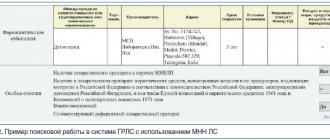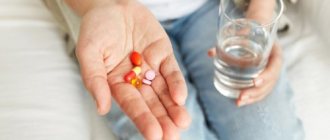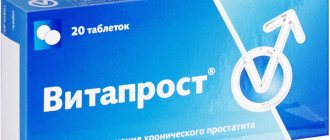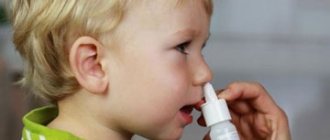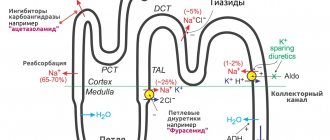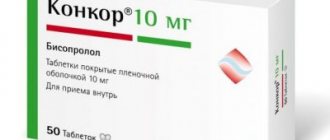Types of receptors[edit | edit code]
Source:
Visual Pharmacology
.
Author
: X. Lulman.
Per. with him. Ed.
: M.: Mir, 2008
Receptors are macromolecules that are capable of attaching biologically active carrier substances, resulting in a change in cellular function. Receptors differ in structure and type of signal transmission (signal transduction).
G protein-coupled receptors (A)
, consist of an amino acid chain that repeatedly penetrates the membrane in the form of a-helices. Outside the membrane, the receptors are associated with sugar residues (glycosylated). It is assumed that the seven transmembrane domains are arranged in a circle, and in the center there is a recess with special transporter binding sites. The addition of a transporter or similar agonist causes a change in the conformation of the receptor proteins, allowing access to the G protein (guanine nucleotide-binding protein). The G protein is located on the inner side of the membrane and consists of three subunits: a, β and y. Different G proteins differ in the structure of their α subunits. Contact with the receptor leads to the activation of the G protein, which in turn affects other proteins (enzymes, ion channels). Many carrier substances act through G protein-coupled receptors.
An example of a ligand-gated ion channel
(B) is the nicotinic cholinergic receptor of the motor neuron. The receptor complex consists of five subunits; each contains four transmembrane domains. The simultaneous attachment of two molecules of acetylcholine (ACh) to both α-subunits leads to the opening of ion channels for Na+ entry (and K+ exit), membrane depolarization and the occurrence of an action potential. N-Cholinoceptors of the ganglia consist only of a- and β-subunits (a2pz). Some GAB K receptors (the ligand for which is γ-aminobutyric acid) also belong to this type of receptor: the GAB K receptor contains one chloride channel (and, in addition, a benzodiazepine binding site).
To ligand-dependent enzymes
(B) refers to the insulin receptor, which is a catalytic receptor. If insulin attaches to the extracellular binding site, then tyrosine-nase activity is “turned on” in the intracellular part. Phosphorylation of proteins leads to changes in cell function. Growth hormone receptors are also of the catalytic type.
Receptors regulating protein synthesis
(D) are characteristic of steroid hormones and thyroid hormones. Receptor proteins are located in the cytosol of the cell (eg, glucocorticoids, mineralocorticoids, androgens, gestagens) or in the nucleus (eg, estrogens, thyroid hormones). After the transporter attaches, the hidden domain of the receptor protein is released and it becomes possible to attach nucleotides to the DNA chain and transcribe certain genes. The ligand-receptor complex is a regulator of transcription, which is most often activated and less often blocked.
Hormone receptor complex
interacts with DNA in the form of dimers. Dimers can consist of two identical hormone receptor complexes (homodimers, for example, in adrenal hormones or sex hormones). The thyroid hormone-receptor complex forms a heterodimer with the cis-retinoic acid-receptor complex.
Receptors of pharmacological drugs[edit | edit code]
The receptor theory of drug action began to develop at the end of the 19th century, when P. Erilich put forward the concept of a drug as a “magic bullet” aimed at the “targeted receptor.” For many years, receptors were characterized by the effects of various endo- and exogenous compounds, the names of which determined the nomenclature of the receptors.
Direct identification of receptors for drugs, hormones, and neurotransmitters became possible in the 60s of the 20th century. thanks to the development of radioligand analysis methods. A deeper understanding of the structure and function of receptors in the last two decades has been achieved on the basis of molecular genetic studies. Most of the receptors have been isolated, their amino acid sequence has been determined, and hundreds of receptor-encoding genes have been cloned.
Most modern researchers distinguish receptor binding from nonspecific binding, first of all, since the latter does not lead to a specific effect.
Signaling mechanisms
Not all drugs affect receptors that have endogenous ligands: the pharmacological effect can be mediated by enzymes, non-protein elements - lipids, changes in the ion content and composition of water, and other processes.
The interaction of drugs with specific receptors is ensured by various types of chemical bonds. Sometimes covalent binding occurs, but pharmacological drugs are characterized by reversible binding due to a combination of electrostatic interactions, hydrogen bonds, van der Waals bonds with high complementarity of the ligand to the receptor. The receptor must also be stereoselective for optical isomers of drugs.
Signaling mechanisms.
Today, there are four main mechanisms by which extracellular ligand regulates intracellular processes. The molecular basis of transduction signaling systems varies considerably.
The first, and most complex, is the G protein-coupled receptor system. It consists of a transmembrane receptor to which a ligand attaches on the cell surface; this receptor couples with a guanine nucleotide-binding protein (G-protein) located on the inner surface of the membrane. This protein in turn regulates an effector enzyme that generates an intracellular second messenger.
The second type of receptor system is the receptors associated with tyrosine kinase and guanylyl cyclase. They consist of transmembrane receptors in which the intracellular part has enzymatic activity that is allosterically regulated by ligand binding at the receptor site external to the membrane.
The third type is a simpler receptor system, a ligand-gated transmembrane ion channel. Its open state is determined by direct binding of the ligand to the extracellular region of channel-forming proteins.
The fourth type is characteristic of fat-soluble ligands. In this case, the ligand that has penetrated the membrane binds to the intracellular receptor, then this complex attaches to a specific DNA site in the nucleus and regulates transcription.
To understand the pharmacogenetic significance of the ligand-receptor interaction, the transduction mechanisms should be considered in more detail.
Studying the mechanisms of action of drugs
- Enzyme-linked immunosorbent assay (ELISA);
- Western blot and Northern blot;
- Polymerase chain reaction (PCR, PC-PCR, RT-PCR);
- Determination of gene polymorphism;
- Determination of the activity of transcription factors;
- High performance liquid chromatography (HPLC).
Publications on the topic:
- Kashkin VA and De Witte P. Ethanol but not acetaldehyde induced changes in brain taurine: a microdialysis study. Amino. Acids. 2004. Vol.26. P.117-124.
- Kashkin VA, Bagrov AY, Fedorova OV, Bagrov YY, Agalakova NI, Patkina NA, Zvartau EE Marinobufagenin (MBG) suppression of ethanol-seeking behavior is associated with inhibition of brain cortex Na/K-ATPase in mice. Eur. Neuropsychopharmacol. 2002. Vol.12, P.217-223.
- Kryshen KL, Atsapkina AA, Akulova EG, Rynchukovsky MS, Makarova MN, Pozharitskaya ON, Shikov AN, Makarov VG, Dadali A. Anti-inflammatory effects of two peat distillates on the model of carrageenan air pouch in the rat. // Phytopharm. 2011. 15th International congress. Book of abstracts. Nuremberg.Germany 25-27 July 2011. P.70-71.
- Kryshen KL, Demchenko DV, Ribakova AV, Rydlovskaya AV, Atsapkina AA, Beketova DV, Pozharitskaya ON, Makarova MN, Dadali VA, Makarov VG Biochemical basis of antiiflamatory properties of peptide complex obtained from the cod liver (Cadidae) // Abstracts. Phytopharm. 2012. Obzory po klinicheskoj farmacologii i lekarstvennoj terapii. -2012. –Vol. 10, No. 2. –M73.
- Ribakova AV, Kovaleva MA, Kryshen KL, Avdeeva OI, Makarenko IE, Makarova MN, Makarov VG Antiiflamatory properties of peptide complex obtained from the cod liver (Cadidae) on the model of adjuvant arthritis in the rat // Abstracts. Phytopharm. 2012. Obzory po klinicheskoj farmacologii i lekarstvennoj terapii. -2012. –Vol. 10, No. 2. –M93.
- Rydlovskaya AV, Gonchar IV, Gushсhin VA, Tesakova SV, Stolashuk NV, Makarov VG, Tikhonov VP Study of mechanisms of action of a new non-steroidal anti-inflammatory remedy of plant origin// Abstr. Book of Nordic Natural Products Conference, – June 13-15 2007. – Sankt Helene, Denmark, 2007. – P. 57.
- Kryshen K.L., Atsapkina A.A., Rybakova A.V., Demchenko D.V., Rydlovskaya A.V., Pozharitskaya O.N., Makarova M.N., Makarov V.G. Dual selective inhibitor of cyclooxygenase-2 and 5-lipoxygenase of natural origin // Materials of the IV Congress of Russian Pharmacologists “Innovations in Modern Pharmacology”. September 18-21, 2012, Republic of Tatarstan, Kazan. –M.: 2012. –S. 105.
- Kryshen K.L., Guseva S.I., Tesakova S.V., Atsapkina A.A., Makarova M.N., Shikov A.N., Makarov V.G., Dyachuk G.I. Evaluation of the anti-inflammatory effect of drugs based on sage // Cytokines and inflammation 2009. T.8, No. 4. P.67-72.
- Kryshen K.L., Rybakova A.V., Rydlovskaya A.V., Makarova M.N., Dadali V.A., Makarov V.G. Biochemical basis of the anti-inflammatory action of a new polypeptide complex obtained from cod liver // Materials of the All-Russian youth conference “Pharmacological correction of vital processes. Preclinical and clinical studies of new drugs”, Ufa, July 8-10, 2012 – pp. 92-94.
- Makarov V.G., Makarova M.N., Rydlovskaya A.V., Tesakova S.V. Nutrimetabolomics from the standpoint of systemic assessment of the functioning of metabolic complexes // Nutrition Issues. -2007. -T. 76, No. 3. –S. 4-10.
- Proshin S.N., Makarov V.G., Makarova M.N., Kryshen K.L., Kovshin A.V., Samusenko I.A. Ulcerogenic effect of non-steroidal anti-inflammatory drugs and hepatotoxicity of nimesulide in an experiment on rats // Reviews on wedge. Pharmacol. and lek. therapy. –2012. – T.10, No. 1. – P.28–34.
- Rydlovskaya A.V., Gonchar I.V., Gushchin V.A., Tesakova S.V., Stolaschuk N.V., Makarov V.G. The effect of a new non-steroidal anti-inflammatory drug of plant origin on LPS-induced TNF production? and activation of MAP kinases JNK1/2, p38 and ERK1/2 in vivo // Russian Journal of Allergology (VIII Congress “Modern problems of allergology, immunology and immunopharmacology”, June 27-29. - Moscow, Russia, 2007). – 2007. – No. 3, Appendix 1. – P. 34.
- Rydlovskaya A.V., Gonchar I.V., Tesakova S.V., Stolaschuk N.V., Gushchin V.A., Makarov V.G. Determination of the effect of the anti-inflammatory combined herbal preparation artroflex on the signaling of MAP kinases p38, JNK1/2 and ERK1/2 and nuclear factor kB // International conference “Reception and intracellular signaling”, June 5-7, 2007. – Pushchino, Russia, 2007. – pp.333-335.
- Rydlovskaya A.V., Makarov V.G. On the mechanisms of anti-inflammatory action of boswellic acids // Materials of the 10th International. Congress "Current problems of creating new drugs of natural origin", June 22-25, 2006. - St. Petersburg, Russia, 2006. - P.754-759.
- Rydlovskaya A.V., Makarov V.G. Mechanisms of anti-inflammatory and immunomodulatory effects of diferuloylmethane // Bulletin of the Ural Medical Academy of Sciences. – 2006. – T.3, No. 1. – P.208-210.
- Tesakova S.V., Samusenko I.A., Karachinskaya I.V., Kryshen K.L., Abrashova T.V., Makarova M.N., Makarov V.G. Experimental model of cervical lymphadenitis in rats to assess the anti-inflammatory effectiveness of drugs // Preventive and Clinical Medicine. 2011. 38(1). 57–63.
- Kryshen K.L., Demchenko D.V., Shikov A.N., Pozharitskaya O.N., Makarova M.N., Makarov V.G. To the mechanism of the anti-inflammatory action of the complex isolated from cod liver. Antiexudative action. (Message 1). // International Bulletin of Veterinary Medicine. -2013, No. 4. -WITH. 100-105. To the mechanism of the anti-inflammatory action of the complex isolated from cod liver. Antiexudative effect
- Kryshen K.L., Faustova N.M., Pozharitskaya O.N., Shikov A.N., Makarova M.N., Makarov V.G. The mechanism of the anti-inflammatory action of the complex isolated from cod liver. Inhibition of COX-2 and 5-LOG. Message #2. // International Bulletin of Veterinary Medicine. -2014, No. 1. -WITH. 80-84. The mechanism of the anti-inflammatory action of the complex isolated from cod liver. Inhibition of COX-2 and 5-LOG
- Shikov A.N., Pozharitskaya O.N., Makarova M.N., Makarov V.G. Biotechnological preparations from hydrobionts and their pharmacology // Cytokines and inflammation. -2014. -T. 13, no. 1. -WITH. 132-133.
- Kastornova A.E., Kryshen K.L., Beketova D.D., Makarova M.N., Makarov V.G. The influence of the allobetulinol derivative on humoral and cellular immune responses // Cytokines and inflammation. -2014. -T. 13, no. 2. -WITH. 34-38.
- Goryacheva M.A., Kryshen K.L., Katelnikova A.E., Akulova E.G., Makarova M.N., Makarov V.G. Methodological aspects of using rat basophils of the RBL-2H3 line to study degranulation // Molecular Medicine. -2016. -T. 14, No. 3. –P.48-52.
- Katelnikova A.E., Kryshen K.L., Makarova M.N., Makarov V.G., Shikov A.N. Mechanisms of the anti-inflammatory action of a complex of glycosylated polypeptides isolated from sea urchins of the genus STRONGYLOCENTROTUS DROEBACHIENSIS // Russian Immunological Journal. -2018. -T. 12(21), no.1. -WITH. 73-79.
- Urakova I.N., Kryshen K.L., Pozharitskaya O.N., Gavrilin M.V., Shikov A.N., Makarova M.N., Makarov V.G. Comparative study of the interaction with the insulin receptor of a number of domestic substances of human insulin and its analogues using the surface plasmon resonance method // Development and registration of medicines. -2018, No. 3(24). -WITH. 112-119.
- Makarova M.N., Makarov V.G. Experimental models for the evaluation of monoclonal antibodies in respiratory diseases. Laboratory animals for scientific research. – 2021, No. 4. https://doi.org/10.29296/2618723X-2019-04-05
- Akbarov US, Pozharitskaya ON, Laakso I., Seppänen-Laakso T., Urakova IN, Vuorela H., Makarov VG, Shikov AN Metabolite profiling and mechanisms of bioactivity of snake autolysate – A traditional Uzbek medicine // Journal of Ethnopharmacology. – 2021. – Vol. 25. – 112459. doi: 10.1016/j.jep.2019.112459.
- Kiseleva I., Stepanova E., Krutikova E., Donina S., Rekstin A., Bazhenova E., Pisareva M., Katelnikova A., Kryshen K., Muzhikyan A., Grigorieva E., Rudenko L. Could trivalent LAIV protect against both genetic lineages of influenza B virus? //VaccineResearch. – 2020. – Vol. 11. – P. 13-24. DOI: 10.29252/vacres.6.1.13.
- Kosman V.M., Tyutina K.V., Dadali Yu.V., Karlina M.V. permeability of aglycones of some flavonoids in the Caco2 model “New achievements in chemistry and chemical technology of plant raw materials”: materials of the VIII All-Russian conference. Barnaul. October 5-9, 2020
Enzyme-related receptors[edit | edit code]
Guanylate cyclase receptors.
Only one class of such receptors is known for a family of peptide hormones called atrial natriuretic peptides (ANP).
They are secreted by muscle cells in response to increased blood pressure and bind to receptors in the kidneys, where they induce an increase in sodium and water excretion, and in vascular smooth muscle, causing their relaxation. The ANP receptor is a single polypeptide containing an extracellular ANP-binding domain, a single transmembrane domain, and an intracellular guanylate cyclase catalytic domain. Activation of the receptor leads to increased production of cGMP, which in turn activates serine-threonine kinases, cGMP-dependent protein kinase (protein kinase G). The target proteins of protein kinase G and the signaling cascades leading to the response to AN P are not well understood. Ligand-gated ion channels
Ligand-gated ion channels
. Synaptic neurotransmitters bind to a group of receptors on postsynaptic membranes known as ligand-gated ion channels. Among them are acetylcholine, γ-aminobutyric acid, glycine, glutamate. Ligand-gated ion channels are the most important targets for the action of drugs, especially psychotropic drugs. Different ion channels are similar in structure; they consist of several subunits that form an ion channel in the membrane. Each channel subunit is a polypeptide containing four membrane-spanning domains. At the same time, they are characterized by specificity of neurotransmitter binding and selectivity of ion transport.
In this class, the H-acetylcholine receptor is the most fully characterized. This ion channel consists of 5 subunits (2a, 5, Tsy), which together form a pore passing through the plasma membrane. The closed position of the two α-subunits inside the membrane forms a “gate” that prevents the passage of ions through the channel. Acetylcholine, joining the extracellular regions of two α-subunits, causes conformational changes in them, leading to the opening of a channel for ions, especially for Na+, which, according to the chemical gradient, go into the cell.
- Intracellular receptors
- Tyrosine kinase receptors
- Proteins as receptor-carrying molecules
- G protein coupled receptors
- Physico-chemical aspects of reception
- Drug interaction with receptors
Source:
Types of action of drugs
THE EFFECT OF THE DRUGS CAN BE:
1. LOCAL and RESORPTIVE.
LOCAL action of drugs develops at the site of their use. For example, the analgesic effect of local anesthetics novocaine, lidocaine, etc.
The resorptive effect of drugs develops after absorption into the blood and penetration to the target organ through histohematic barriers (for example: cardiac glycosides: digoxin, corglycone, etc. have their main positive inotropic effect on the heart muscle as a result of their resorptive effect).
2. DIRECT and INDIRECT (in some cases, reflex action).
The direct effect of drugs develops directly in the target organ. This action can be local, for example: the local anesthetic lidocaine has a local analgesic effect, and resorptive, for example, the local anesthetic lidocaine is used as an antiarrhythmic drug, in order for lidocaine to have a therapeutic effect in ventricular tachyarrhythmias of the heart, lidocaine must be absorbed into the blood and pass histohematic barriers to the source of arrhythmia in the heart tissue.
Indirect action can be considered using the example of the action of cardiac glycosides (digoxin, strophanthin, etc.). Digoxin has a stimulating effect on the contractility of the heart muscle, resulting in an increase in cardiac output. The speed of blood flow increases and perfusion (blood flow) in the kidneys increases. This leads to an increase in diuresis (the amount of urine increases). Thus, digoxin indirectly increases diuresis through stimulation of myocardial contractility.
The reflex effect of drugs develops when in one place of the body the drug changes the activity of receptors, and as a result of this effect, the function of an organ changes in another place of the body (for example: ammonia, stimulating the receptors of the nasal mucosa leads to stimulation of the cells of the respiratory center of the brain , as a result, the frequency and depth of breathing increases).
- SELECTIVE and NON-SELECTIVE.
Selective (elective) action of drugs
drugs are carried out by influencing certain receptors (for example: prazosin blocks predominantly L1|-adrenergic receptors) or drugs can accumulate in a certain organ and have an inherent effect (for example: iodine selectively accumulates in the thyroid gland, and there changes the function of this organ). In clinical practice, it is believed that the higher the selectivity of the action of a drug, the less toxicity and severity of negative side reactions.
Non-selective action of drugs, a term opposite to the selective effect (for example: the anesthetic drug fluorotane indiscriminately blocks almost all types of receptor formations in the body, mainly in the nervous system, which leads to an unconscious state, that is, anesthesia).
- REVERSIBLE and IRREVERSIBLE.
The reversible effect of drugs is due to the fragility of chemical interactions with receptor formations or enzymes (hydrogen bonds, etc.; for example: an anticholinesterase drug of a reversible type of action - proserin). An irreversible effect occurs when the drug binds tightly to receptors or enzymes (covalent bonds; for example: an anticholinesterase drug with an irreversible type of action - Armin). 5. MAIN and SIDE. The main effect of a drug is the effect of the drug aimed at treating the underlying disease (for example: doxazosin - an alpha-1 adrenergic blocker used to treat hypertension).
Side effects are the effects of a drug that are not aimed at treating the underlying disease. The side effect can be POSITIVE (for example: doxazosin, during a course of treatment of hypertension, inhibits the growth of the prostate gland and normalizes the tone of the sphincter of the bladder, and, therefore, can be used for prostate adenoma and urination disorders) and
NEGATIVE (for example: doxazosin can cause transient tachycardia when treatment of hypertension, and withdrawal syndrome is also often recorded). AGONISTS are drugs that excite receptor formations. For example: orciprinaline sulfate (asmopent) stimulates β2-adrenergic receptors of the bronchi and leads to expansion of the lumen of the bronchi. ANTAGONISTS - drugs that block the stimulation of receptors (metoprolol blocks beta-1 adrenergic receptors in the heart muscle and reduces the force of heart contraction). AGONIST-ANTAGONIST - drugs that have the properties of both stimulating and inhibiting receptor formations. For example: pindolol (Wisken) blocks beta-1 and beta-2 adrenergic receptors. However, pindolol has the so-called “intrinsic sympathomimetic activity”, that is, the drug, by blocking beta-adrenergic receptors and preventing the effect of the mediator on these receptors for a certain time, also has some stimulating effect on the same beta-adrenergic receptors. Doses of medicines


